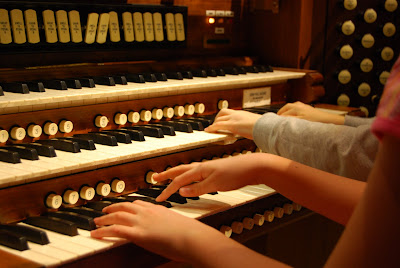
Here is the group! These are most but not all of my students. 21 of these students in the picture have been studying with me for less than 18 months. I have heard a lot of progress this year!
I really enjoyed this year-end recital; We made sure that most students did not stretch to play their hardest pieces so they were very comfortable performing. I heard a lot of genuine musicality, phrasing, dynamics and real involvement in the music making experience, from all ages and levels. As the teacher I felt so comfortable and, well, thrilled at what was happening from the beginning. I'd already done a bad thing setting up that night by spilling an entire gallon of apple juice on the carpet- I felt like I was setting the tone for a bad night- but no way- it was awesome. The students really shone. I also really appreciated how well behaved the kids all were: they were supportive of each other, nobody was running around and playing pianos... At first the shop owner was really worried about the crowd we had coming- over 100 people! But they all behaved beautifully, and he was definitely happy: the parents were quickly cleaning up at the end- 10 minutes with several hard workers had all the chairs away, cookies cleaned up, everything back in order. (...Now if we could only get the piano teacher not to drop the apple juice jug!!)
Afterwards we enjoyed getting photos taken by a professional photographer ...as well as the obligatory cookie reception. What a great evening!
Saturday, December 10 2011, 6:00 Recital Program (Last names edited out for privacy)
Ella, 5
Lemonade Stand (Faber)
All My Friends (Faber)
Firefly (Faber)
Violet, 3
Frogs on Logs (Faber)
D-E-F March (Faber)
Marching (Dmitri Kabalevsky)
Sriya, 6
The Juggler (Faber)
“This is Not Jingle Bells” (Faber)
Sarah, 8
The Haunted Mouse (Faber)
The Grumpy Old Troll (Faber)
Ashwin, 6
Young Hunter (Faber)
Canoe Song (Faber)
Luke C, 7
Marching (Dmitri Kabalevsky)
Red Feather (W. E. Robinson)
Luke D, 6
Romantic Story (Gurlitt)
Luke B, 7
The Sleeping Dragon (Nancy Telfer)
Reflections and Swooping Blues (Paul Sheftel)
Livi, 9
Morning at Spring Meadow (Hartsell)
Sowmya, 9
Aria (Daniel Speer)
Gavotte (Handel)
Rowan, 8
Dance of the Irish (Faber)
Taylor, 10
Don’t Wanna Leave You Blues (Martha Meir)
Drew (13) and Taylor
Hush a Bye and Jamaica Farewell (Folk Tunes)
David, 10
Theme from New World Symphony, mvt. 2 (Dvorak)
Pumpkin Boogie (Faber)
Chloe, 6
Dance Song (Sperontes)
Grandfather’s Musical Clock (Rohde)
Amber, 6
Sonatina in G Major (Thomas Attwood)
Morning at Spring Meadow (Randall Hartsell)
Jackie, 7
Ballerina in a Chinese Garden (Composed by Jackie)
The Great Escape (Randall Hartsell)
Daniel, 9
Relay Race (Jon George)
Sonata in D minor K. 90d (Scarlatti)
Andrew, 12
Clowns (Dmitri Kabalevsky)
Arabesque (Burgmuller)
Eashan, 7
Musette (J. S. Bach)
Sonatina in G major, Mvt. 1 (Beethoven)
Jamin, 8
Jazz Sonatina,Mvt.1: Rhythmic (Robert Vandall)
Emily, 8
Recollections (Randall Hartsell)
Stella, 10
Invention No. 8 in F major (J. S. Bach)
Sonatina in F major mvt. 2: Rondo (Beethoven)
Haily, 12
Prelude No. 16 in D flat Major (Robert Vandall)
Katie, 16
Waltz in A minor (Edvard Grieg)
Lauren, 13
Fur Elise (Beethoven)
Dan, 17
Scherzo from Sonata in E flat Major (Beethoven)
Stefan, 15
Sonata in C minor Mvt. 1: Molto Allegro (Mozart)
Dawson, 17
Canon in D by Pachelbel (duet with Ms. Bonnie)
Improvisation
On a different note, we are preparing for another recital entirely, to happen next week... starring three of these students!















 his manuscripts that were too often taken from his writing desk and ending up lining her muffin tins and ending up as curl-papers for Mrs. Haydn's coiffure. I am Dead Serious. This really happened. This is one of those situations that would make even the most hardened marriage counselor's jaw drop. Well, needless to say, their relationship did not flourish because she was like this on a regular basis. They separated, whether amicably or not I cannot tell, but he supported her comfortably in her own home and regarded himself as a married man the rest of his life. This I really, really respect about him: Haydn wrote to a friend who was suggesting the beginning of a relationship between Haydn and one of his students, a rich, handsome widow who obviously preferred him: "I am not a free man." Haydn recognized that vows are forever.
his manuscripts that were too often taken from his writing desk and ending up lining her muffin tins and ending up as curl-papers for Mrs. Haydn's coiffure. I am Dead Serious. This really happened. This is one of those situations that would make even the most hardened marriage counselor's jaw drop. Well, needless to say, their relationship did not flourish because she was like this on a regular basis. They separated, whether amicably or not I cannot tell, but he supported her comfortably in her own home and regarded himself as a married man the rest of his life. This I really, really respect about him: Haydn wrote to a friend who was suggesting the beginning of a relationship between Haydn and one of his students, a rich, handsome widow who obviously preferred him: "I am not a free man." Haydn recognized that vows are forever.